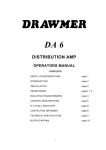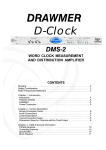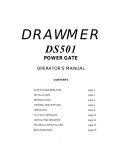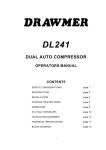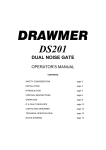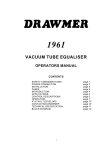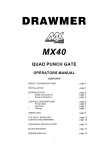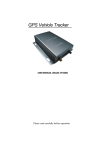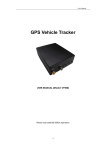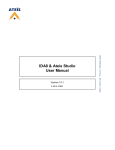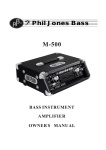Download Drawmer 1969 Specifications
Transcript
1969 VACUUM TUBE COMPRESSOR OPERATORS MANUAL CONTENTS SAFETY CONSIDERATIONS page 1 INTRODUCTION page 2 APPLICATIONS page 2 INSTALLATION page 3 CONTROL DESCRIPTIONS: " Compressor " Microphone Pre-amplifier " Auxiliary Input page page page page QUICK SET-UP page 8 IF A FAULT DEVELOPS page 9 CONTACTING DRAWMER page 9 TECHNICAL SPECIFICATION page 10 BLOCK DIAGRAM page 11 i 5 5 7 7 COPYRIGHT This manual is copyrighted © 2008 by Drawmer Electronics, Ltd. With all rights reserved. Under copyright laws, this manual may not be duplicated in whole or in part without the written consent of Drawmer. ONE YEAR LIMITED WARRANTY Drawmer Electronics Ltd., warrants the Drawmer 1969 audio processor to conform substantially to the specifications of this manual for a period of one year from the original date of purchase when used in accordance with the specifications detailed in this manual. In the case of a valid warranty claim, your sole and exclusive remedy and Drawmer’s entire liability under any theory of liability will be to, at Drawmer’s discretion, repair or replace the product without charge, or, if not possible, to refund the purchase price to you. This warranty is not transferable. It applies only to the original purchaser of the product. For warranty service please call your local Drawmer dealer. Alternatively call Drawmer Electronics Ltd. at +44 (0)1709 527574. Then ship the defective product, with transportation and insurance charges pre-paid, to Drawmer Electronics Ltd., Coleman Street, Parkgate, Rotherham, S62 6EL UK. Write the RA number in large letters in a prominent position on the shipping box. Enclose your name, address, telephone number, copy of the original sales invoice and a detailed description of the problem. Drawmer will not accept responsibility for loss or damage during transit. This warranty is void if the product has been damaged by misuse, modification or unauthorised repair. THIS WARRANTY IS IN LIEU OF ALL WARRANTIES, WHETHER ORAL OR WRITTEN, EXPRESSED, IMPLIED OR STATUTORY. DRAWMER MAKES NO OTHER WARRANTY EITHER EXPRESS OR IMPLIED, INCLUDING, WITHOUT LIMITATION, ANY IMPLIED WARRANTIES OF MERCHANTABILITY, FITNESS FOR A PARTICULAR PURPOSE, OR NON-INFRINGEMENT. PURCHASER’S SOLE AND EXCLUSIVE REMEDY UNDER THIS WARRANTY SHALL BE REPAIR OR REPLACEMENT AS SPECIFIED HEREIN. IN NO EVENT WILL DRAW MER ELECTRONICS LTD. BE LIABLE FOR ANY DIRECT, INDIRECT, SPECIAL, INCIDENTAL OR CONSEQUENTIAL DAMAGES RESULTING FROM ANY DEFECT IN THE PRODUCT, INCLUDING LOST PROFITS, DAMAGE TO PROPERTY, AND, TO THE EXTENT PERMITTED BY LAW, DAMAGE FOR PERSONAL INJURY, EVEN IF DRAWMER HAS BEEN ADVISED OF THE POSSIBILITY OF SUCH DAMAGES. Some states and specific countries do not allow the exclusion of implied warranties or limitations on how long an implied warranty may last, so the above limitations may not apply to you. This warranty gives you specific legal rights. You may have additional rights that vary from state to state, and country to country. In the interests of product development, Drawmer reserve the right to modify or improve specifications of this product at any time, without prior notice. ii 1969 OPERATORS’ MANUAL 1 DRAWMER 1969 Dual Vacuum Tube Compressor SAFETY CONSIDERATIONS CAUTION - MAINS FUSE TO REDUCE THE RISK OF FIRE REPLACE THE MAINS FUSE ONLY WITH A FUSE THAT CONFORMS TO IEC 127-2. 250 VOLT WORKING, TIME DELAY TYPE WITH A BODY SIZE OF 20mm x 5mm. THE MAINS INPUT FUSE MUST BE RATED AT 250mA WHERE THE MAINS INPUT VOLTAGE SWITCH IS SET TO 230 VOLTS AC. AND 500mA WHERE THE MAINS INPUT VOLTAGE IS 115 VOLTS AC. THE REAR PANEL H.T. FUSE MUST ALWAYS BE RATED AT 50mA, IRRESPECTIVE OF THE MAINS VOLTAGE SETTING. CAUTION - MAINS CABLE DO NOT ATTEMPT TO CHANGE OR TAMPER WITH THE SUPPLIED MAINS CABLE. CAUTION - SERVICING DO NOT PERFORM ANY SERVICING. REFER ALL SERVICING TO QUALIFIED SERVICE PERSONNEL. WARNING TO REDUCE THE RISK OF FIRE OR ELECTRIC SHOCK DO NOT EXPOSE THIS EQUIPMENT TO RAIN OR MOISTURE. 2 1969 OPERATORS’ MANUAL INTRODUCTION The 1969 is a hybrid vacuum tube/semi-conductor, dual-channel compressor which has numerous applications in studio recording, live sound, location recording, postproduction and as part of a musician's rack system. The microphone input stages feature extremely low noise, balanced input circuitry with additional tube amplification, enabling modern microphones to take on the characteristics of older tube models. APPLICATIONS " " " " " " " General studio compressor Complete stereo mixes. For high quality location recording, the 1960 makes the perfect partner for a DAT machine, as it combines the functions of stereo mic preamp with that of a compressor. The mic inputs provide up to 60dB of gain. As an instrument amplifier, the 1969 provides gain, EQ and compression, providing the type of overdrive sound associated with tube guitar amplifiers. When the compressor is overdriven, it can be used creatively on electric guitar or rock vocal sounds. The Aux input may be used for processing the output from a dedicated guitar preamplifier, where the EQ can be used to further tailor the sound before it is compressed. 1969 OPERATORS’ MANUAL 3 INSTALLATION The 1969 is designed for standard 19" rack mounting and occupies 2U of rack space. Avoid mounting the unit directly above power amplifiers or power supplies that radiate significant amounts of heat and always connect the mains earth to the unit. Fibre or plastic washers may be used to prevent the front panel becoming marked by the mounting bolts. Because the tube circuitry generates more heat than an equivalent solid-state design, it is advisable to leave space above the unit to allow the heat to dissipate. AUDIO CONNECTIONS The inputs and outputs are electronically balanced on conventionally wired XLRs (pin 1 screen, pin 2 hot, pin 3 cold and XLR shell is connected to chassis). The 1969 fully conforms to the EMC standards, if the unit is used where it maybe exposed to high levels of disturbance such as found close to a TV or radio transmitter we suggest that the screen of the signal cable is connected to the chassis connection on the XLR type connector. The operating level is nominally +4dBu. If earth loop problems are encountered, do not disconnect the mains earth but instead, try disconnecting the signal screen on one end of the cables connecting the outputs of the 1969 to the patchbay. Balanced operation is recommended. The side-chain access point and the two different level insert points are unbalanced. The side chain feature on the 1969 is part of the compressor feedback stage and would normally be connected to a normalised or semi-normalised pair of patchbay contacts. This would allow the user to insert additional EQ for some de-essing, or frequency conscious compression. The intended use of the audio insert jacks would be to patch in EQ (eg 1961), reverb or similar processing. Connection is via stereo ¼" jacks, the wiring convention being: ring is signal send, tip is signal return and sleeve ground. 4 1969 OPERATORS’ MANUAL POWER CONNECTION The unit will have been supplied with a power cable suitable for domestic power outlets in your country. For your own safety it is important that you use this cable. The unit should always be connected to the mains supply earth using this cable. If for some reason the unit is to be used at a mains input operating voltage which is different to that as supplied, the following procedure must be carried out. (see following diagram) 1: Disconnect the unit from the mains. 2: With a size1 pozidrive screwdriver, remove the two self-tapping screws holding the voltage selection switch cover plate on the rear panel. 3: Remove the cover plate and slide the switch fully to its opposite end. 4: Rotate the cover plate one half turn, (180E) and refit the two screws. 5: Fit a correctly rated Mains Fuse for the selected operation voltage. Do not make any changes to the HT Fuse. 6: Re-connect to mains power source. 1969 OPERATORS’ MANUAL 5 CONTROL DESCRIPTION AND OPERATION With the exception of the Aux preamp section, both channels of the 1969 are identical and may be used independently or linked for stereo operation. In both the linked modes, only Channel 1 compressor controls are functional and serve as the stereo master. In Stereo Link mode, both channels track together to avoid the inevitable image shifting that would occur if the two channels of a stereo signal were treated independently. COMPRESSOR Source Select: This rotary switch selects the compressor input source. The Line and Mic inputs are via the rear-panel XLRs while the Aux input is available on the front panel. The two Mic positions offer an input with or without +48V phantom powering, with a red LED lit when active. Note: if the Aux input is to be used at the same time as a Mic input, it is recommended that the Mic input be processed through the upper channel and the Aux input through the lower channel as this minimises crosstalk between tube amplification stages sharing the same envelope. Phase Reverse: This will invert the phase of the selected input signal. Use of the Phase Rev feature is usually required in multimic situations where phase anomalies or arrival time discrepancies need to be compensated for. It is advisable to check for mono compatibility when using phase reversal within a multi-mic arrangement. High-pass: The signal path incorporates a switchable high-pass filter which may be set to 50Hz, 100Hz or Off. Its use is to attenuate low frequency signals that might otherwise prove troublesome, eg. traffic rumble or stage vibration. Threshold: Determines the input level above which gain reduction will be applied and may be set in the range -20dB to infinity. Because the compression system is based on the Soft Knee principle, the onset of compression is progressive, so no Ratio control is necessary. 6 1969 OPERATORS’ MANUAL Attack: Six switchable Attack settings are provided giving various settings. The actual attack time is further modified by the release setting chosen. Attack Times: 1 2 3 4 5 6 Release: There are three fixed Release times and a further three which are programme dependent. Switch settings 1 through to 3 provide progressively increasing release times, while positions 4, 5 and 6 cause the release times to vary in a manner which automatically adapts to the dynamics of the incoming signal, as detailed below:- Release Times 1 2 3 4 5 6 Output: (Gain) The Output level may be amplified, or attenuated by up to 20dB to compensate for level changes caused by compression. VU Meter: A moving coil VU meter monitors either the level of the output signal (over the range -10dB to +10dB with reference to the +4dBu operating level) or the amount of gain reduction taking place. Because the meter has VU characteristics, it closely reflects what is actually being heard, though will not respond quickly enough to register short signal peaks. VU / GR: Switches the meters to show either the output level (VU) or the amount of gain reduction (GR). Norm/Bypass S/C Listen: 2 ms 8 msec 15 msec 25 msec 30 msec 50 msec 100 ms (Fixed) 500 msec (Fixed) 1 sec (Fixed) Semi-Auto 200 ms to 2 sec Signal dependent Semi-Auto 500 ms to 5 sec signal dependent Automatic 1 sec to 10 sec signal dependent Normal mode, the signal is passed through the compressor. Bypass takes the compressor and the vacuum tubes out of circuit path; the output signal is taken from the signal insert return point. S/C Listen routes the side-chain signal directly to the output allowing the effects of any additional side-chain processing, such as equalisation, to be monitored. 1969 OPERATORS’ MANUAL 7 Stereo Link: This makes Channel 1 controls the stereo master and disables the compressor stage of channel 2 when the unit is used for processing a stereo signal. Since the same gain reduction is applied to both audio channels no image shifting can occur. Big Link: Makes the compressor side chain less sensitive to low bass frequencies, so reducing the ducking effect caused by bass energy and effectively boosting the bass output. MICROPHONE PRE-AMPLIFIER Mic Input Gain: This switchable control sets the mic input gain over the range 0 to 66dB in 6dB steps. The adjacent Clip LED illuminates when excessive Mic gain has been applied and there is a danger of clipping. AUXILIARY INPUT The Auxiliary Input has a 2M2Ù impedance and feeds a specialised instrument input stage which provides both gain and equalisation, suitable for use with both active and passive guitar pickup systems as well as with electronic keyboards. The passive Bass and Treble controls are based on those used in classic tube guitar amplifiers while the Bright switch puts a peak in the frequency response at around 2kHz to simulate the voicing of a typical guitar amplifier. A two position high or low gain switch provides an additional 10dB of gain when required for level matching or for creating overdrive effects. When setting up a good starting point is to switch Bright 'On' and set the compressor for '3' attack and '6' release. The threshold should be adjusted to give a gain reduction reading of around 5dB on signal peaks. By increasing the Gain control setting, the input stage can be made to overdrive in a manner similar to that of traditional valve guitar amplifiers. 8 1969 OPERATORS’ MANUAL Bass EQ: Passive equaliser control, which can be set to provide up to 15dB of bass boost at 40Hz. Treble EQ: Passive equaliser control, which can be set to provide up to 18dB of treble boost at 16kHz. Gain: Provides up to 30dB of gain at the Low Gain switch setting or 40dB at the High Gain setting. Low/High: Sensitivity selector switch. Adds 10dB of gain in the High position. Flat/EQ: Switches the equaliser controls out of circuit when a flat response is required, or for 'A/B' comparison of EQ effectiveness. Norm/Bright: Switches in 10dB of boost at 2kHz in the Bright position, ( when 'EQ' has been selected on the Flat/EQ switch.) QUICK SET UP " " " " " " " Select Stereo Link mode for use with a stereo signal, otherwise ensure this switch is Off. Choose correct signal source for each channel using selector. Initially, set the Attack selector to 3 (a Medium position) and set Release to 6 (Programme Dependent). Set the Mode switch to Normal and the Meter switch to GR. With programme material playing, adjust the Threshold control until the desired amount of gain reduction registers on the meters. Use the Output Gain control to restore any level lost due to compression. If necessary, change the Attack and Release settings to suit the material. 1969 OPERATORS’ MANUAL 9 IF A FAULT DEVELOPS For warranty service please call Drawmer Electronics Ltd. Or their nearest authorised service facility, giving full details of the difficulty. On receipt of this information, service or shipping instructions will be forwarded to you. No equipment should be returned under the warranty without prior consent from Drawmer or their authorised representative. For service claims under the warranty agreement a service Returns Authorisation (RA) number will be given. Write this RA number in large letters in a prominent position on the shipping box. Enclose your name, address, telephone number, copy of the original sales invoice and a detailed description of the problem. Authorised returns should be prepaid and must be insured. All Drawmer products are packaged in specially designed containers for protection. If the unit is to be returned, the original container must be used. If this container is not available, then the equipment should be packaged in substantial shock-proof material, capable of withstanding the handling for the transit. CONTACTING DRAWMER Drawmer Electronics Ltd., will be pleased to answer all application questions to enhance your usage of this equipment. Please address correspondence to: Drawmer (Technical Help line) : Coleman St.: Parkgate : Rotherham : S62 6EL : UK or, E-mail us on : [email protected] Drawmer dealers, Authorised service departments and other contact information can be obtained from our web pages on http://www.drawmer.com 10 1969 OPERATORS’ MANUAL TECHNICAL SPECIFICATIONS (All measurements taken at +4dBu operating level) INPUT IMPEDANCES LINE MIC AUX 20KÙ 150Ù to 600Ù 2M2Ù MAXIMUM INPUT LEVEL +20dBu OUTPUT IMPEDANCE 50 Ù MAXIMUM OUTPUT LEVEL +22dBm (balanced) BANDWIDTH <10Hz to 22KHz -1dB UNITY GAIN NOISE BYPASS LINE MIC (E.I.N) CROSSTALK (All Channels) !95dB !85dB !134.5dB shorted !130.5dB @ 150Ù !129.8dB @ 200Ù Better than 80dB DISTORTION (THD & Noise) 1KHz Line Input with BYPASS selected < 0.01% Line Input with NORMAL selected < 0.35% POWER REQUIREMENTS 230Volt or 115Volt at 50-60Hz,38 W atts FUSE RATING 250mA for 230Volt, 500mA for 115Volt CONFORMING TO IEC 127-2 FUSE TYPE 20mm x 5mm, Class 3 Slo-Blo, 250Volt working CASE SIZE 482mm (w) x 88mm (h) x 250mm (d) WEIGHT (incl packaging) 6.0 Kgs 1969 OPERATORS’ MANUAL 11 BLOCK DIAGRAM














